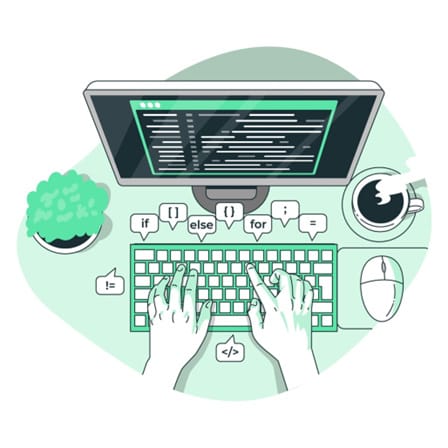 Image from Freepik
Image from Freepik
The realm of software development is in a constant state of evolution, driven by technological advancements and the ever-changing demands of the market. As we delve into 2024, several key trends are shaping the industry, influencing how developers work, what technologies they adopt, and the kinds of applications they create. This article explores the most significant software development trends that are defining this year, offering insights into the future of the field.
1.The Rise of Low-Code and No-Code Platforms
Democratizing Software Development
Low-code and no-code platforms are revolutionizing the software development landscape by making it more accessible to non-developers. These platforms provide intuitive, drag-and-drop interfaces that allow users to build applications without needing in-depth coding knowledge. As businesses strive to accelerate digital transformation, these tools are becoming indispensable.
Accelerating Time-to-Market
One of the primary benefits of low-code and no-code platforms is the significant reduction in development time. By enabling rapid prototyping and iteration, these platforms help companies bring products to market faster, which is crucial in today’s fast-paced environment. Moreover, they allow developers to focus on more complex tasks, thereby optimizing resource utilization.
2. Artificial Intelligence and Machine Learning Integration
Enhancing Software Capabilities
Artificial Intelligence (AI) and Machine Learning (ML) continue to integrate deeply into software development. In 2024, we are seeing more sophisticated AI models that enhance various aspects of software, from predictive analytics and personalized user experiences to advanced automation and decision-making capabilities.
Development Process Automation
AI and ML are also transforming the software development process itself. Automated code generation, bug detection, and testing are just a few areas where these technologies are making a significant impact. AI-driven tools are helping developers write cleaner, more efficient code and identify potential issues before they become problematic.
3. Cloud-Native Development
Leveraging Cloud Infrastructure
Cloud-native development is becoming the standard as organizations seek to leverage the scalability, flexibility, and cost-efficiency of cloud infrastructure. This approach involves designing applications specifically for cloud environments, using microservices architecture and containerization technologies like Docker and Kubernetes.
Enhanced Collaboration and Deployment
Cloud-native development facilitates continuous integration and continuous deployment (CI/CD), enabling teams to collaborate more effectively and deploy updates more frequently. This trend is crucial for maintaining competitiveness in a market where rapid innovation is necessary.
4. Edge Computing
Bringing Computation Closer to Data Sources
Edge computing is gaining traction as a solution to the latency and bandwidth limitations of cloud computing. By processing data closer to its source, edge computing reduces latency, enhances real-time processing capabilities, and improves overall system efficiency. This trend is particularly relevant for applications requiring immediate data processing, such as IoT devices, autonomous vehicles, and industrial automation.
Enhancing Security and Privacy
In addition to performance benefits, edge computing also offers enhanced security and privacy. By keeping sensitive data closer to its point of origin, organizations can reduce the risks associated with data transmission and centralized storage. This aspect is becoming increasingly important as data privacy regulations tighten globally.
5. Cybersecurity as a Priority
Proactive Security Measures
With the growing complexity of cyber threats, cybersecurity remains a top priority in software development. In 2024, we are witnessing a shift towards proactive security measures, incorporating security practices early in the development lifecycle through DevSecOps. This approach ensures that security is an integral part of the development process rather than an afterthought.
Advanced Threat Detection
AI and ML are playing critical roles in advancing threat detection and response capabilities. By leveraging these technologies, developers can build systems that detect anomalies, identify potential threats, and respond to incidents in real-time. This proactive approach is essential for protecting sensitive data and maintaining user trust.

6. Quantum Computing
Preparing for the Quantum Leap
Quantum computing, though still in its nascent stages, is beginning to influence software development. As quantum computers become more powerful and accessible, developers are exploring quantum algorithms and their potential applications. This trend is driving the need for new skills and tools to harness the capabilities of quantum computing effectively.
Practical Applications
In 2024, we are seeing initial practical applications of quantum computing in fields such as cryptography, optimization, and complex simulations. While widespread adoption is still a few years away, staying ahead of this trend will position developers to capitalize on the opportunities quantum computing presents.
7. Enhanced Developer Experience (DevEx)
Focusing on Developer Productivity
Improving the developer experience (DevEx) is a critical focus area in 2024. Tools and platforms that enhance productivity, streamline workflows, and reduce friction are in high demand. This includes advanced integrated development environments (IDEs), better collaboration tools, and comprehensive documentation.
Mental Health and Well-Being
There is also a growing recognition of the importance of mental health and well-being among developers. Organizations are adopting practices and tools to reduce burnout, such as flexible work schedules, mental health resources, and supportive work environments. A positive DevEx is essential for maintaining a motivated and effective development team.
8. Sustainable Software Development
Green Coding Practices
Sustainability is becoming a crucial consideration in software development. Green coding practices focus on writing efficient code that minimizes energy consumption and reduces the environmental impact of software. Developers are increasingly aware of their role in promoting sustainability and are adopting practices that align with this goal.
Corporate Responsibility
Beyond individual efforts, companies are also taking a more holistic approach to sustainability. This includes optimizing data centers for energy efficiency, utilizing renewable energy sources, and promoting sustainable practices throughout the software development lifecycle.
Conclusion
The software development landscape in 2024 is characterized by rapid technological advancements and a focus on efficiency, security, and sustainability. From the democratization of development through low-code and no-code platforms to the integration of AI, ML, and quantum computing, these trends are shaping the future of the industry. As developers and organizations navigate this dynamic environment, staying abreast of these trends will be crucial for maintaining competitiveness and driving innovation. Embracing these changes will not only enhance the development process but also lead to the creation of more robust, secure, and sustainable software solutions.

